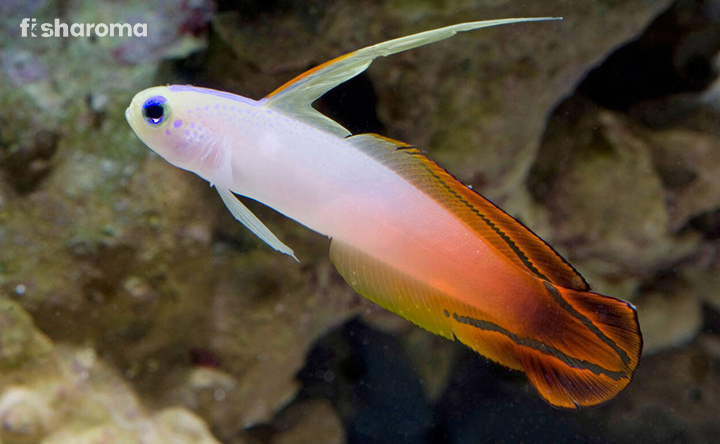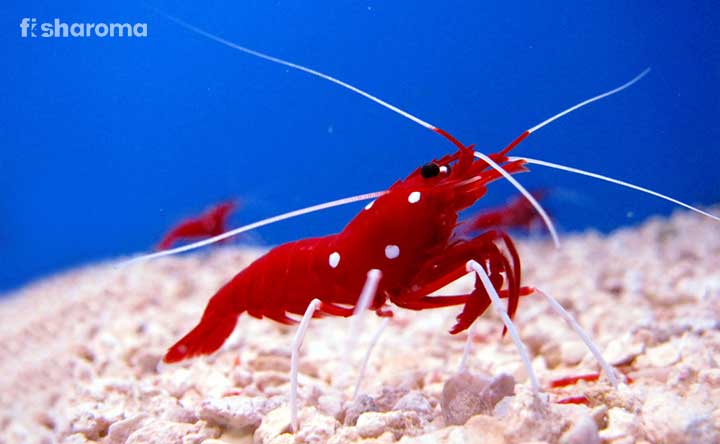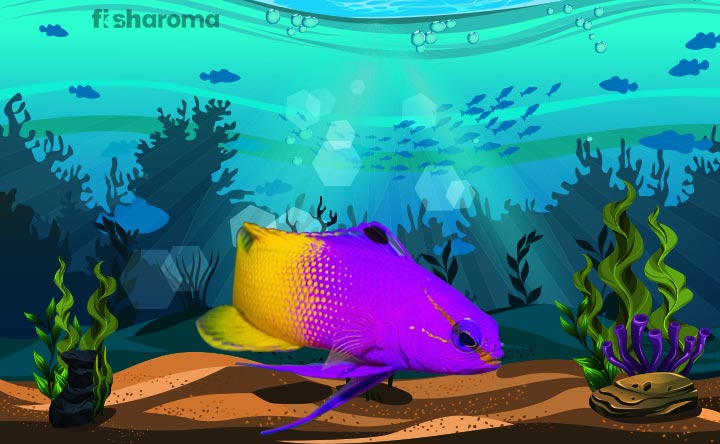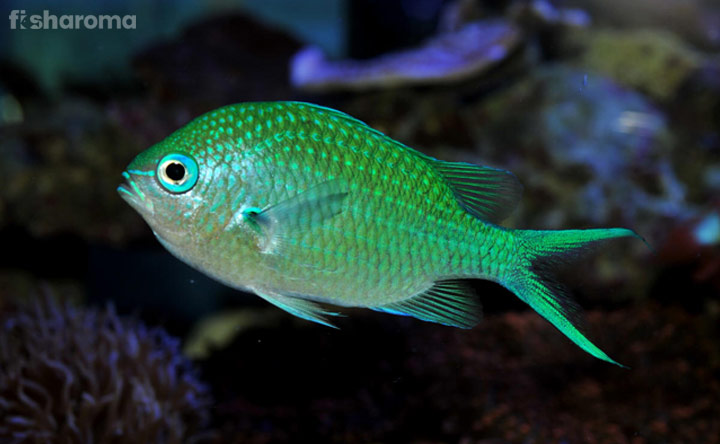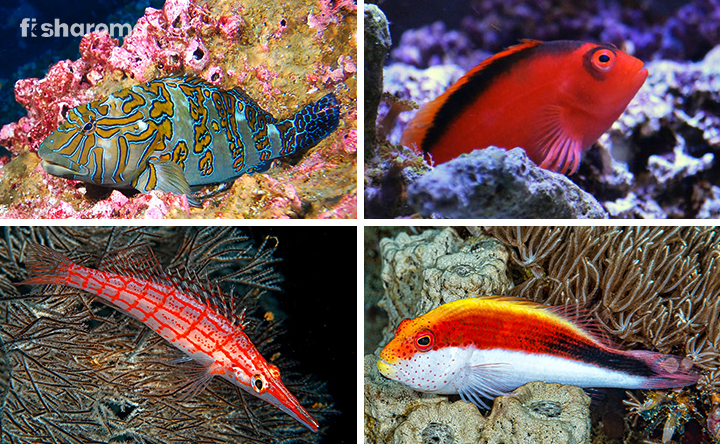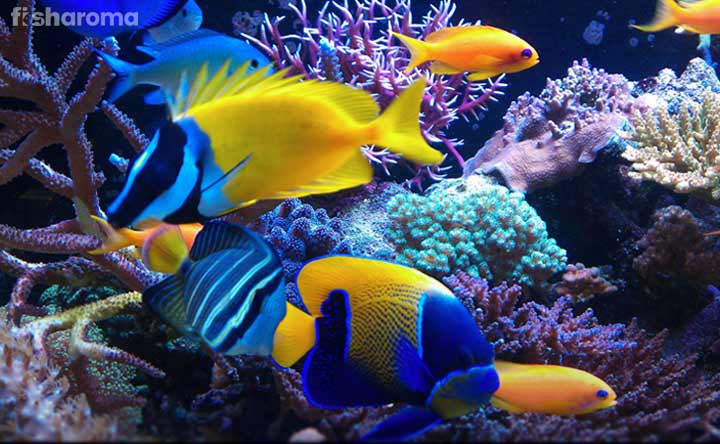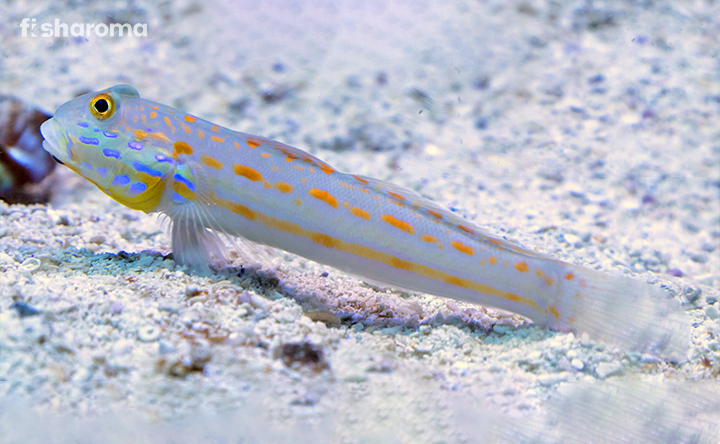Yellow Coris Wrasse: A Care Guide To The Impressive Saltwater Pest Fighter
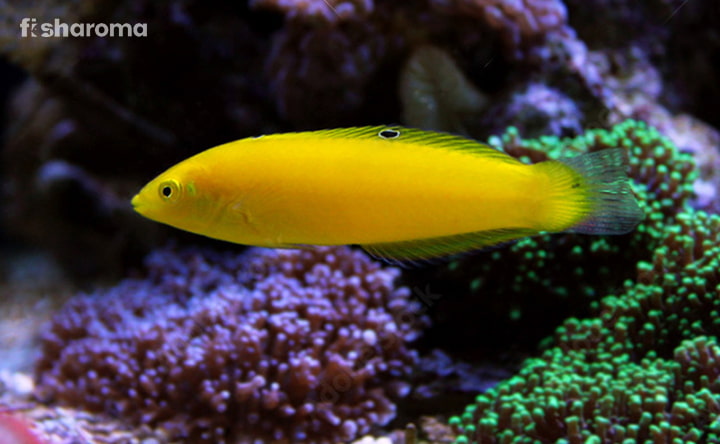
- Origin & Habitat of Yellow Coris Wrasse
- Appearance of Yellow Coris Wrasse
- Behaviour of Yellow Coris Wrasse
- Lifespan of Yellow Coris Wrasse
- Diet of Yellow Coris Wrasse
- Tank Requirements for Yellow Coris Wrasse
- Water Type for Yellow Coris Wrasse
- Compatibility of Yellow Coris Wrasse
- Breeding of Yellow Coris Wrasse
- Disease and Treatment of Yellow Coris Wrasse
- Summary
Yellow Coris Wrasse is a celebrated saltwater fish from the Wrasse family. They belong to the Actinopterygii class and Labriformes order. These fishes are very much admired by many marine aquarists due to their calm demeanour, easy-care level and small size.
Yellow Coris Wrasses are also very attractively coloured and patterned. They help keep the general tank health clean by fighting pests. They are also popularly regarded as ‘deep-sea pest fighters’.
Taking care of a Yellow Coris Wrasse is not at all a herculean task. As these fishes feed on anything that’s fleshy and small invertebrates, their food is readily available.
If you are fascinated by Yellow Coris Wrasses and want to have one as your pet then, you are at the right place! We are here to help you out with expert guidance on their care, requirements and lifestyle.
Read through to know it all!
Key Specifications of Yellow Coris Wrasse
Yellow Coris Wrasse is one beautiful and intriguing creature. If they pique your interest then, the table below gives a brief description of their traits and requirements.
| Scientific Name | Halichoeres chrysus |
| Origin | Indian and Pacific Ocean |
| Lifespan | 7-10 years |
| Colour | Bright Yellow |
| Temperament | Peaceful and docile |
| Size | 5 inches |
| Diet | Carnivore |
| Family | Labridae |
| Compatibility | Other peaceful and similar-sized species of fishes |
| Tank Size | 40-50 Gallons |
| Care Level | Easy |
| Water Temperature | 22.2-25.5 Degrees Celsius |
| Water Conditions | pH 8.1-8.4 |
| Breeding | Egg-layer |
Overview
Yellow Coris Wrasse (Halichoeres chrysus) is also commonly known as Golden Rainbowfish, Golden Wrasse, Canary Wrasse and Yellow Wrasse. These fishes belong to the Labridae family. They have a brilliant golden hue to their skins which makes them very eye-catchy. Additionally, these beauties have a composed nature, are generally shy and don’t bother any other fishes in their natural habitat.
These fishes have a proclivity for burying themselves within the layers of sand at the bottom of the ocean. They hide whenever they feel frightened, stressed or need to rest and sleep. They are fast swimmers and are very full of life.
Yellow Coris Wrasses are quite hardy, resistant to various diseases, and are also comparatively easy to care for. Yet another reason why beginner aquarists often see a Yellow Coris Wrasse as a good option.
When you are deciding to have a Yellow Coris Wrasse as your pet then, you should definitely look into their needs to ensure their healthy survival in captivity. You need to be aware of their lifestyle and tank and water requirements. So, come, let’s have a look at them!
Origin and Habitat of Yellow Coris Wrasse
Yellow Coris Wrasses inhabit the tropical waters of the Eastern Indian ocean, spreading towards the Western Pacific Ocean. They have also been found in the Soloman Islands, to the north of Southern Japan, the coast of Australia in New South Wales and the south of Rowley Shoals.
These fishes thrive in warmer water temperatures, with an alkaline pH and moderate to strong water current. They mostly dwell at the bottom of the ocean, that is on the soft-sandy sea bed. They live amongst the rubbles, rocks, corals and caves.
Appearance of Yellow Coris Wrasse
Yellow Coris Wrasses have a uniqueness in their skin colour and the patterns on it. We’ll have a detailed look at them in the “colour” section below.
Yellow Coris Wrasses have an elongated and thin body frame. Their mouths are located in the front of their heads and they point forward, forming a terminal mouth shape. They have well defined dorsal, pectoral, anal and caudal fins.
Size
Compared to many other Wrasses, a Yellow Coris Wrasse is small in size. They can grow up to a maximum length of 5 inches. Their small size is one reason why most aquarists prefer having them in their saltwater tanks.
A Yellow Coris Wrasse will attain its full size within a year after its birth. However, if the tank is too small or is overcrowded then, there are chances that its growth may get stunted.
Colour
Yellow Coris Wrasses have a bright golden-yellow hue to their skins. Juvenile fishes, during their initial phases of growth, sport two prominent “eyespots” on their dorsal fins and a smaller spot at the base of their caudal fins. As the fishes mature, in their terminal phase, the spots gradually start waning. At this point, you’ll only notice a single eyespot on its dorsal fin. Additionally, you’ll notice that certain green lines appear near a male fish’s face.
Dimorphism
Yellow Coris Wrasses are not dimorphic as they are hermaphrodites. All the fishes are born females, and they switch to male under certain circumstances. There are hardly any distinguishable features between a male and a female fish. A male fish is generally larger and has more vibrant colouration on its body than a female fish.
Behaviour of Yellow Coris Wrasse
Yellow Coris Wrasses typically exhibit docile, shy and calm behaviour. They are content with almost any saltwater tankmates. They love to dig through the sand substrate and bury themselves whenever they feel the need for comfort and sleep.
Another reason why you might often find your Wrasse burying in the sand is when they feel threatened or indisposed in the presence of predatory tankmates. This is their way of safeguarding themselves.
When are they the most active?
During the daytime, you will see that your Yellow Coris Wrasses as at their peak level of energy and activity. They love to hide and play amongst the aquatic plants, caves and rocks and also with other likeable tankmates. When the evening approaches, they gradually glide down to the bottom of the tank, resting on the branches, rocks and on the sand bed.
How do they like their own species?
Yellow Coris Wrasses don’t attune well with fishes of its own kind. In the presence of other Yellow Wrasses, your Wrasse will show territorial aggressiveness. So, it’s always best if you get your baby Wrasses at the same time and make sure that they grow up together, getting comfortable around one another.
Fighters!
Yellow Coris Wrasses are popularly known for being tank-cleaners. They will prey on any nuisance pets and parasites. This not only keeps the tank clean but also saves many other tankmates from potential infections and diseases.
We will have a detailed discussion on this in the “Diet” section below. Keep reading!
Lifespan of Yellow Coris Wrasse
In the wild, Yellow Coris Wrasses can survive up to 10 long years! However, in captivity, you can expect them to live for a maximum of 7 years, that too, if provided with the proper diet and appropriate tank conditions.
Diet of Yellow Coris Wrasse
Yellow Coris Wrasses follow a carnivorous diet. They have got a huge appetite for a variety of meaty and fleshy foods. Make sure that you are keeping track of their meal timings. If these fishes skip a single meal, you’ll start noticing aggressiveness in their behaviours.
You should feed your Yellow Coris Wrasse at least three times a day. They have a high metabolism rate and so, need to be fed more than two times. When you are feeding your Wrasse, watch if they can complete their meals within a few minutes. This would reduce the waste products inside the tank and help with hygiene.
Make sure that their diet is rich in proteins and vitamins.
What do they eat and what can you feed them?
- Frozen Mysis Shrimp
- Brine Shrimp
- Bloodworms
- Blackworms
- Shellfish
- Nori Seaweed sheets
- Copepods
- Frozen, commercially available fish food
- Fish flakes and pellets
- Protein and Vitamin supplement
Note: You should thaw the frozen food before feeding them to your Wrasse.
Yellow Coris Wrasses as Aquarium Pest-cleaners
Yellow Wrasses will feed on anything that’s meaty. This even includes pests. They act as great aquarium pest cleaners. Not only do they remove harmful or unwanted critters from the tank, but they also feed on the parasites off the tank mates.
These fishes will prey on flatworms and Bristle flatworms, which potentially plague other tankmates. They also feed on Nudibranchees, which are a type of sea slugs. Sea Slugs are typically venomous and can cause distress and infections to other species in their natural habitat.
Yellow Coris Wrasses help with the pest control inside the tank by feeding on other nuisances which include Pyramidillid snails, fireworms, tubeworms, feather dusters, wild shrimps and parasites.
Tank Requirements of Yellow Coris Wrasse
Yellow Coris Wrasses are gorgeous and lovable creatures and so, you should make sure that you are properly maintaining the tank conditions for them. In this section, we will talk about the fish’s tank requirements. Before we dig into it, do not forget to check out this expert suggestion on how you should set up your saltwater fish tank.
Tank Size
Although Yellow Coris Wrasses are one of the smallest species of Wrasses, they do still require a minimum tank size of 50 Gallons. These fishes do well in a school of 3-4 individuals. So, a 50-gallon tank will provide each fish with its own space and freedom to swim around and explore.
Tank Shape
Yellow Coris Wrasses love to stay near the bottom of the tank. Also, they love to swim around and explore the environment in which they are living. You should get a rectangular tank for your Yellow Coris Wrasse. Not only will the tank shape allow them to swim freely, but it will also aid in more oxygenation and help the fish breathe more air.
Tank Lid
Yellow Coris Wrasses are known to be great jumpers. These fishes jump off the tank when they feel threatened or intimidated. You should definitely get a lid for their tank. A tank lid which is fit tightly will ensure their safety and will also prevent the entry of dirt and foreign toxic particles. Besides, if you have other pets at home then, a tank lid will add to the necessity.
Substrate
For a Yellow Coris Wrasse, you should get a soft and sandy substrate. These fishes will dig and bury themselves in the sandy substrate when they feel threatened or shied out. A soft-sandy substrate will help them relax as they will hide beneath it and sleep.
You should make sure that the sand level shouldn’t be less than 2-3 inches from the bottom of the tank. This depth will be useful as it will help your Wrasse to dig in quick.
Filter
A good and powerful filtration system is a must for a Yellow Coris Wrasse tank. A strong filtration mechanism will ensure that water remains purified and free of toxins, unwanted chemicals and wastes. Additionally, a filter will also ensure good oxygenation and ventilation.
Ornaments
You would want to make sure that your Yellow Coris Wrasse feels at home inside your aquarium. To achieve this, decorate your aquarium in a way that would mimic its natural habitat.
Add hide-out places like caves, live rocks, blunt stones and coral rubbles.
Yellow Coris Wrasses choose to hide out as one of their most likeable options whenever they feel stressed or threatened.
These decors will not only help your fish relax but will also give a pleasing look to your tank.
Lighting
Yellow Coris Wrasses love to stay in the brightly lighted areas within the tank. However, make sure that the intensity of light is not too powerful. Add rocks in the tank to ensure that your fish also gets some shade from natural sunlight or even artificial lighting. Although these Wrasses love bright lighting, they don’t prefer full or greater intensities of light at all times.
Cleaning Methods
To ensure a healthy life for your Wrasse, you need to take proper and accurate measures to clean the tank and the water inside.
Make sure to change around 10-20% of the tank water at least once or twice a week. Use a sponge or scrapers to clean the inside of the tank’s walls. It’s important that you remove dust, waste and also excess algal growth from the walls of the tank.
We recommend that you use an aquarium vacuum cleaner as well. An aquarium vacuum cleaner will clean the substrate layers of all the stuck and accumulated waste, decomposed particles and food matters. This will keep your tank toxin-free.
Additionally, using activated carbon for your saltwater tank will be a very good decision. Activated carbons rid your tank of all the toxic chemicals, be it organic or inorganic.
Water Types for Yellow Coris Wrasse
You should pay keen attention to the necessary water parameters for a Yellow Coris Wrasse. Although these species of Wrasses are quite sturdy in nature, you cannot eradicate the fact that poor water conditions and improper water parameters might play a big role in affecting their health. Before you introduce your Wrasse to the aquarium, make sure that you have fully cycled the tank.
Water Temperature
Yellow Corris Wrasses require a slightly warmer water temperature between 22.2-25.5 Degrees Celsius. To make sure that the temperature inside the tank is being maintained properly, you will need an aquarium thermometer and a heater.
pH Level
Yellow Coris Wrasses require a slightly basic pH to survive. The pH of the water should be maintained between 8.1 to 8.4. You should properly learn to regulate the pH level inside your saltwater tank.
Specific Water Gravity
The specific water gravity for a Yellow Coris Wrasse should be maintained between 1.020 to 1.025.
Water Flow Rate
For a Yellow Coris Wrasse, you’ll need moderate to strong water circulation inside the tank. Install pumps to maintain the flow rate and the current.
Compatibility of Yellow Coris Wrasse
Yellow Coris Wrasses are peace-loving creatures. They won’t pose trouble to almost any other saltwater fishes. Yellow Coris Wrasses get along quite well with other similar-sized fishes, which have an equally mild temperament.
However, you need to be aware of the fact that Yellow Coris Wrasse will turn noticeably aggressive and would start a fight with one of its own kind. So, it’s always recommended that you keep only one Yellow Coris Wrasse in your tank. Even if you want to house around 2-3 Yellow Wrasses then, make sure that you have gotten them at the same time and that they are growing up together.
You also should avoid slow-moving, timid fishes inside your tank. Yellow Coris Wrasses are quite active during the daytime so, quite naturally they wouldn’t miss a chance to harass the slow-swimmers and even steal their foods.
You should also avoid adding large, aggressive or semi-aggressive species of fishes in your Yellow Corris Wrasse tank. Your Wrasse might get easily intimated by these fishes and, you would often find them stressed and hiding inside the sand burrows or even jumping off the tank.
Suitable Tank Mates
- Clownfish
- Basslets
- Lawnmower Blenny and other Blennies
- Butterflyfish
- Boxfish
- Angelfish
- Surgeonfish
- Firefish
- Green Clown Goby and other Gobies
- Tangs
- Other Species of Wrasses
Unsuitable Tank Mates
- Similar Species of Wrasses
- Banana Wrasses
- Pufferfish
- Dwarf Lionfish
- Peacock Eel and other Eels
- Damselfish
- Panther Grouper and other Groupers
- Flame Cardinalfish
- Neon Dottybacks
Can you house a Yellow Coris Wrasse with smaller invertebrates?
Although Yellow Coris Wrasses are welcoming of many different species of saltwater critters, you should be careful while adding smaller invertebrates to your tank. These fishes won’t mind nipping at and targeting any live fleshy creature. These include snails, crabs and shrimps. If you want to add invertebrates to your tank then, ensure that you are keeping a watch on your Wrass’s behaviour around them.
Is Yellow Coris Wrasse reef-safe?
Yellow Coris Wrasses are generally considered to be reef safe. They don’t pose any threat to the corals or anemones and so, if you want to include them in your tank then, go for it. However, as we have already seen, your reef tank invertebrates may not be safe around a Yellow Coris Wrasse.
To reduce the chances of your Wrasse eating up the tank invertebrates, make sure that the tank is spacious enough so that your Yellow Wrasse has ample space to swim. Also, pay heed to their diet and meal timings. Additionally, if you chose a fish which has been bred in captivity then, the possibility of them attacking reef tank mates will be considerably low.
Breeding of Yellow Coris Wrasse
Yellow Coris Wrasses are all born females. Additionally, they are hermaphrodites. They follow the strategy known as “sequential hermaphroditism”, that is, they switch to a male under certain circumstances which includes behavioural and social triggers or even genetic mutations at times.
Mating Pattern and Behaviour
During the mating season, within a group of 6-7 female fishes, one fish switches its gender to a male. This community of fishes, with 6-7 females and a single male, is called a “harem.”
It is indeed tricky to mate Yellow Coris Wrasse in captivity. This is because the males and females are physically indistinguishable. If you get to witness the entire process of breeding and spawning then, you are one lucky individual.
If you want to breed these fishes then, you should get a large tank so that a harem of Yellow Coris Wrasses could fit in there, get comfortable around each other and live stress-free. They’ll randomly start the process of mating and spawning once they feel ready and restful.
Necessities
The breeding of Yellow Coris Wrasse is a chance factor and you can only hope for success by providing them with the necessities which include a big tank, a powerful filtration system and pleasant decor including caves, live rocks, inverted terracotta pots and definitely, a soft sandy substrate bottom.
What about the Fries?
Once the eggs are laid by the female and fertilised by the male, you should separate the eggs into a new nursery tank. After the eggs hatch, the fries will start swimming freely. Install a proper filtration system, clean the tank and give nutritious food to the fries. Once the fries have grown big enough to join the community, you can put them back in their old tank.
Disease and Treatment of Yellow Coris Wrasse
Although Yellow Corris Wrasses are very resilient, let’s not entirely eradicate the fact that they might get affected by certain common saltwater diseases. Let’s have a look at them and the respective treatments.
Saltwater Ich
This is a bacterial infection which causes your fish to lose appetite and become lethargic. Additionally, you will notice small white spots over the fish’s body and tail.
First, isolate the infected fish to a separate and clean tank for treatment. There you can treat your fish with hyposalinity. Consult a vet if the problem takes a severe turn. To prevent this disease you must inevitably make sure to keep your tank and the water inside it clean. Use a powerful filter and regularly change the tank water.
Dropsy
Dropsy is again a common saltwater bacterial infection which results in bloating. This is caused due to the accumulation of fluids inside the fish’s body.
Dropsy requires immediate treatment and a vet consultation. To prevent this disease, make sure that you are keeping an eye on the tank water conditions, keeping it clean and eliminating every chance of bacterial and parasitic growth. Feed your fish the best quality food. Certain Penicillin-based drugs can also cure dropsy in your fish. Refer to the doctor.
Summary
On a closing note, Yellow Coris Wrasses are an extremely good choice for your reef aquarium. They are very zestful and exuberant and so, you will love watching them roaming around inside the tank. Besides, they have gorgeously tinted skin, are calm and will get along with most marine critters. They are also very easy to care for and their relatively small size won’t pose a problem for beginner aquarists.
Furthermore, quite amazingly, you would be fascinated when you watch them dig in and burrow in the layers of the sand substrate. After all, who wouldn’t love to watch a fish preparing itself for bedtime?
Yellow Coris Wrasses are also a healthy option for your reef aquarium as they are natural pest-cleaners. They will rid your tank of parasites, snails, and other critters that might threaten the general health of the tank and the fishes inside.
All these reasons sum up why saltwater aquarists love the idea of having a Yellow Coris Wrasse as their pet. If you are looking forward to introducing one of these into your family then, all the best! You’ll have a wonderful journey ahead! Your Golden Rainbowfish will certainly ameliorate your mood and their presence will patently prettify your reef tank.
Similar Care Guides
If you have enjoyed reading this article then, do visit our website for similar articles on different types of fishes.
- Care Guide for Coral Beauty Angelfish: These types of Dwarf Angelfishes are very popular among many saltwater aquarists. They are absolutely gorgeous, with a vibrant colouration on their bodies.
- Care Guide for Yellow Watchman Goby: This Goby species will be an adorable addition to your tank. They have a unique pattern on their skins. Additionally, these fishes have a mild temperament.
- Care Guide for Bicolour Blenny: These species of Blennies would make a great addition to your saltwater aquarium. As the name suggests, they have this unique lateral division of two different colours on their body.


